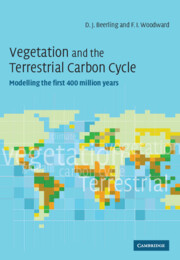Book contents
- Frontmatter
- Contents
- Preface
- Acknowledgements
- 1 Introduction
- 2 Investigating the past from the present
- 3 Climate and terrestrial vegetation
- 4 Climate and terrestrial vegetation of the present
- 5 The late Carboniferous
- 6 The Jurassic
- 7 The Cretaceous
- 8 The Eocene
- 9 The Quaternary
- 10 Climate and terrestrial vegetation in the future
- 11 Endview
- References
- Index
11 - Endview
Published online by Cambridge University Press: 09 August 2009
- Frontmatter
- Contents
- Preface
- Acknowledgements
- 1 Introduction
- 2 Investigating the past from the present
- 3 Climate and terrestrial vegetation
- 4 Climate and terrestrial vegetation of the present
- 5 The late Carboniferous
- 6 The Jurassic
- 7 The Cretaceous
- 8 The Eocene
- 9 The Quaternary
- 10 Climate and terrestrial vegetation in the future
- 11 Endview
- References
- Index
Summary
General issues
This book has achieved what might be considered an idiosyncratic view of terrestrial plant life since its first appearance in the Silurian period, over 400 million years ago. Particular eras have been selected for examination, primarily because GCMs have already been run for these eras and so climate fields are available for driving a vegetation model. However, as indicated in the Introduction, these eras have been selected for good geological and investigative reasons. Over the period of 400 million years many geological processes, which seem too slow for contemporary investigation, have exerted very large influences on the Earth and its terrestrial vegetation. In particular, plate tectonics have changed the geography of the continents and movements of the Earth's crust have created mountains. In combination, these major processes have also caused massive outgassing of greenhouse gases (Marzoli et al., 1999), with attendant changes in climate and vegetation (McElwain et al., 1999). The timescales of these events are familiar in the realm of geology, yet this book has emphasised biology, in which the familiar timescales are much shorter. The integration of these timescales can be most readily achieved by considering the carbon cycle, which is central to the whole theme of this book.
The carbon cycle
A familiar representation of the contemporary carbon cycle (Fig. 11.1, from Houghton et al. 1996) indicates the pools of carbon in the atmosphere, vegetation and soil, the oceans and an estimate of fossil fuels.
- Type
- Chapter
- Information
- Vegetation and the Terrestrial Carbon CycleThe First 400 Million Years, pp. 353 - 360Publisher: Cambridge University PressPrint publication year: 2001



